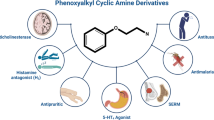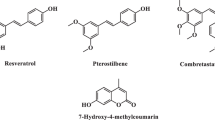Abstract
Modification of steroid molecules by introducing heterocyclic ring into the core structure of steroids has been utilized as an attractive approach for either cancer prognosis or diagnosis. Several new cholestanoheterocyclic steroids were synthesized, and analytical and spectral data proved the validity of the novel synthesized steroid derivatives. The cytotoxicity of synthesized compounds 3, 4, 5, 7, 9, 10, 13, 15b, and 16b was evaluated using human colorectal cancer HCT 116 and Caco-2, cervical cancer HeLa, hepatoma HepG2, and breast cancer MCF7 cell lines. Intriguingly, compound 13 has the highest cytotoxic effect when applied on the majority of cancer cells. In conclusion, compound 13 may be considered as a promising anticancer candidate against all cancer cell lines, because it recorded the lowest IC50 of the majority of the cancer cell lines used. Furthermore, a molecular docking study was employed to determine the binding modes against aromatase cytochrome P450 (CYP19), cyclin-dependent kinase 2 (CDK2), and B-cell lymphoma (BCL-2) proteins, which are major proteins involved in the pathogenesis of cancer. Molecular docking analyses revealed that compounds 13, 3, and 5 (free energy of binding = − 9.2, − 9.1, and − 9.0 kcal/mol, respectively) were the best docked ligand against aromatase CYP19; compounds 16b, 3, 9, and 10 (free energy of binding = − 9.6, − 9.3, and − 9.2 kcal/mol, respectively) were the best docked ligand against CDK2, while compounds 15b, 16b, and 13 (free energy of binding = − 9.1, − 9.0, and− 8.7 kcal/mol, respectively) were the best docked ligand against BCL2. In conclusion, compounds 3, 13, and 16b were the most promising compounds with the lowest IC50s against most of the tested cancer cell lines, and they displayed the lowest binding energies, critical hydrogen bonds, and hydrophobic interactions with the three molecular targets compared to other tested compounds.















Similar content being viewed by others
References
Al-Said, M. S., Bashandy, M. S., Al-qasoumi, S. I., & Ghorab, M. M. (2011). Anti-breast cancer activity of some novel 1,2-dihydropyridine, thiophene and thiazole derivatives. European Journal of Medicinal Chemistry, 46(1), 137–141.
Mohamed, M. F., Mohamed, M. S., Shouman, S. A., Fathi, M. M., & Abdelhamid, I. A. (2012). Synthesis and biological evaluation of a novel series of chalcones incorporated pyrazole moiety as anticancer and antimicrobial agents. Applied Biochemistry and Biotechnology, 168(5), 1153–1162.
Filippova, M., Evans, W., Aragon, R., Filippov, V., Williams, V. M., Hong, L., Reeves, M. E., & Hughes, P. D. (2014). The small splice variant of HPV16 E6, E6, reduces tumor formation in cervical carcinoma xenografts. Virology, 450, 153–164.
Naumann, J. M., Zöllner, A., Drăgan, C. A., Messinger, J., Adam, J., & Bureik, M. (2011). Biotechnological production of 20-alpha-dihydrodydrogesterone at pilot scale. Applied Biochemistry and Biotechnology, 165(1), 190–203.
Tantawy, M. A., Nafie, M. S., Elmegeed, G. A., & Ali, I. A. I. (2017). Auspicious role of the steroidal heterocyclic derivatives as a platform for anti-cancer drugs. Bioorganic Chemistry, 73, 128–146.
Elhinnawi, M. A., Mohareb, R. M., Rady, H. M., Khalil, W. K. B., Abd Elhalim, M. M., & Elmegeed, G. A. Novel pregnenolone derivatives modulate apoptosis via Bcl-2 family genes in hepatocellular carcinoma in vitro. The Journal of Steroid Biochemistry and Molecular Biology in press.
Mohareb, R. M., Elmegeed, G. A., Baiuomy, A. R., Eskander, E. F., & William, M. G. (2011). Evaluation of anti-inflammatory, anti-nociceptive and anti-ulcerogenic activities of novel synthesized thiazolyl and pyrrolyl steroids. Archiv der Pharmazie - Chemistry in Life Sciences, 344(9), 595–604.
Ahmed, H. H., Elmegeed, G. A., & Abdelhalim, M. M. (2005). Synthesis and screening of certain new pyrazolo, pyrimidino and pyrido-androstane derivatives for androgenic and antiandrogenic activity. Bulletin of Faculty of Pharmacy Cairo University, 43, 147–159.
Shan, L. H., Liu, H. M., Huang, K. X., Dai, G. F., Cao, C., & Dong, R. J. (2009). Synthesis of 3beta, 7alpha, 11alpha-trihydroxy-pregn-21-benzylidene-5-en-20-one derivatives and their cytotoxic activities. Bioorganic & Medicinal Chemistry Letters, 19(23), 6637–6639.
Park, K. K., Ko, D. H., You, Z., Khan, M. O., & Lee, H. J. (2006). In vitro anti-inflammatory activities of new steroidal antedrugs: [16alpha,17alpha-d] Isoxazoline and [16alpha,17alpha-d]-3′-hydroxy-iminoformyl isoxazoline derivatives of prednisolone and 9-alpha-fluoroprednisolone. Steroids, 71(3), 183–188.
Yat-Ching, T. (2011). The role of cholesterol in prostatic diseases. Urological Science, 22, 97–102.
Radwan, A. A., & Alanazi, F. K. (2014). Targeting cancer using cholesterol conjugates. Saudi Pharmaceutical Journal, 22(1), 3–16.
Preethi, B., Shanthi, V., & Ramanathan, K. (2015). Investigation of nalidixic acid resistance mechanism in Salmonella enterica using molecular simulation techniques. Applied Biochemistry and Biotechnology, 177(2), 528–540.
Karthick, V., Shanthi, V., Rajasekaran, R., & Ramanathan, K. (2012). Exploring the cause of oseltamivir resistance against mutant H274Y neuraminidase by molecular simulation approach. Applied Biochemistry and Biotechnology, 167(2), 237–249.
Baskaran, C., & Ramachandran, M. (2012). Computational molecular docking studies on anticancer drugs. Asian Pacific Journal of Tropical Disease, 734–738.
Bruno, R. D., & Njar, V. C. O. (2007). Targeting cytochrome P450 enzymes: a new approach in anti-cancer drug development. Bioorganic & Medicinal Chemistry, 15(15), 5047–5060.
Nurse P, Masui Y, Hartwell L. (1998). Understanding the cell cycle [Internet]. Nature Medicine. [cited 2018 Sep 10]. Available from: https://www.nature.com/articles/nm1098_1103 .
Elmegeed, G. A., Yahya, S. M. M., Abd-Elhalim, M. M., Mohamed, M. S., Mohareb, R. M., & Elsayed, G. H. (2016). Evaluation of heterocyclic steroids and curcumin derivatives as anti-breast cancer agents: studying the effect on apoptosis in MCF-7 breast cancer cells. Steroids, 115, 80–89.
Mohamad Rosdi, M. N., Mohd Arif, S., Abu Bakar, M. H., Razali, S. A., Mohamed Zulkifli, R., & Ya’akob, H. (2018). Molecular docking studies of bioactive compounds from Annona muricata Linn as potential inhibitors for Bcl-2, Bcl-w and Mcl-1 antiapoptotic proteins. Apoptosis, 23(1), 27–40.
Kirkin, V., Joos, S., & Zörnig, M. (2004). The role of Bcl-2 family members in tumorigenesis. Biochimica et Biophysica Acta BBA - Molecular Cell Research, 1644(2), 229–249.
Bajwa, N., Liao, C., & Nikolovska-Coleska, Z. (2012). Inhibitors of the anti-apoptotic Bcl-2 proteins: a patent review. Expert Opinion on Therapeutic Patents, 22(1), 37–55.
Gacs-Baitz, E., Minuti, L., & Taticchi, A. (1996). Synthesis and complete 1H and 13C NMR analysis of some 4-androsten-3-one derivatives. Synop, 27, 324–325.
Mosmann, T. (1983). Rapid colorimetric assay for cellular growth and survival: application to proliferation and cytotoxicity assays. Journal of Immunological Methods, 65(1–2), 55–63.
Jemal, A., Siegel, R., Ward, E., Hao, Y., Xu, J., Murray, T., & Thun, M. J. (2008). Cancer statistics cancer. Jornal dos Clinicos, 58, 71–96.
Pedretti, A., Villa, L., & Vistoli, G. (2004). VEGA—an open platform to develop chemo-bio-informatics applications, using plug-in architecture and script programming. Journal of Computer-Aided Molecular Design, 18(3), 167–173.
Trott, O., & Olson, A. J. (2010). AutoDock Vina: improving the speed and accuracy of docking with a new scoring function, efficient optimization and multithreading. Journal of Computers & Chemistry, 31, 455–461.
Pettersen, E. F., Goddard, T. D., Huang, C. C., Couch, G. S., Greenblatt, D. M., Meng, E. C., & Ferrin, T. E. (2004). UCSF chimera—a visualization system for exploratory research and analysis. Journal of Computational Chemistry, 25(13), 1605–1612.
Armstrong, R. W., Combs, A. P., Tempest, P. A., Brown, S. D., & Keating Acc, T. A. (1996). Multiple-component condensation strategies for combinatorial library synthesis. Accounts of Chemical Research, 29, 123–131.
Funding
The authors acknowledge the financial support of the National Research Centre, Cairo, Egypt: grant no. 10010105 for Prof Gamal A. Elmegeed and grant no. 11010335 for Dr. Mohamed A. Tantawy.
Author information
Authors and Affiliations
Corresponding author
Ethics declarations
Conflict of Interest
The authors declare that they have no conflict of interest.
Ethical Approval
This article does not contain any studies with human participants or animals performed by any of the authors.
Additional information
Publisher’s Note
Springer Nature remains neutral with regard to jurisdictional claims in published maps and institutional affiliations.
Rights and permissions
About this article
Cite this article
El-Kady, D.S., Abd Rabou, A.A., Tantawy, M.A. et al. Synthesis and Evaluation of Novel Cholestanoheterocyclic Steroids as Anticancer Agents. Appl Biochem Biotechnol 188, 635–662 (2019). https://doi.org/10.1007/s12010-018-02943-6
Received:
Accepted:
Published:
Issue Date:
DOI: https://doi.org/10.1007/s12010-018-02943-6




